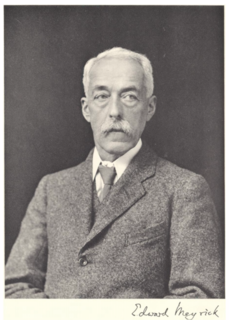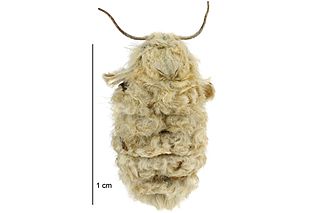Related Research Articles

Edward Meyrick was an English schoolmaster and amateur entomologist. He was an expert on microlepidoptera and some consider him one of the founders of modern microlepidoptera systematics.

Scrobipalpa aptatella is a moth of the family Gelechiidae. It is found in China (Xinjiang), Australia, New Zealand, Samoa, India, Indonesia (Sumatra), Malaysia, Myanmar, Sri Lanka, Palestine and in Africa, where it has been recorded from the Democratic Republic of Congo, Kenya, Malawi, Namibia, South Africa, Tanzania and Zimbabwe.
Coleophora crypsineura is a moth of the family Coleophoridae, first described by Oswald Bertram Lower in 1900 as Batrachedra crypsineura.

Metacrias erichrysa is a species of moth of the family Erebidae. It is endemic to New Zealand. This species can be found in the lower half of the North Island and western alpine areas of the South Island. The adult female of the species is flightless and buff coloured whereas the male is brightly coloured and a rapid flier during daylight hours. The male of the species is on the wing from mid-November to early January. The species inhabits open herb and tussock fields in mountainous terrain at altitudes of between 900 and 1200 m. Larvae feed on Brachyglottis bellidioides,Festuca novae-zealandiae and indigenous species from the genera Acaena, Muehlenbeckia, Wahlenbergia and Raoulia.
Chloroclystis catastreptes, the green and brown carpet, is a moth in the family Geometridae. It was described by Edward Meyrick in 1891. It is found in Australia.
Gymnoscelis bryodes is a moth in the family Geometridae. It was described by Alfred Jefferis Turner in 1907. It is found in Australia.
Gymnoscelis chlorobapta is a 9 millimetres (0.35 in) long moth in the family Geometridae. It is found in Australia (Queensland).
Gymnoscelis tanaoptila is a moth in the family Geometridae. It was described by Alfred Jefferis Turner in 1907. It is found in Australia (Queensland).
Heliocausta floridula is a moth in the family Oecophoridae. It was described by Edward Meyrick in 1913. It is found in Australia, where it has been recorded from Western Australia, New South Wales and Victoria.
Chezala carella is a moth in the family Oecophoridae. It was described by Francis Walker in 1864. It is found in Australia, where it has been recorded from Queensland.
Dichomeris holomela is a moth in the family Gelechiidae. It was described by Oswald Bertram Lower in 1897. It is found in Australia, where it has been recorded from New South Wales, Western Australia, the Northern Territory and Queensland.
Ardozyga exarista is a species of moth in the family Gelechiidae. It was described by Edward Meyrick in 1904. It is found in Australia, where it has been recorded from the state of Western Australia.
Acraephnes sulfurata is a moth in the family Depressariidae. It was described by Edward Meyrick in 1907. It is found in Australia, where it has been recorded from South Australia and Western Australia.
Thudaca stadiaula is a moth in the family Depressariidae. It was described by Edward Meyrick in 1893. It is found in Australia, where it has been recorded from Western Australia.
Heosphora psamathella is a moth in the family Pyralidae. The species was first described by Edward Meyrick in 1879, as Anerastia psamathella, from a male specimen collected in Sydney, New South Wales, and was moved to the genus Heosphora as its type species by George Hampson in 1901. It is found in Australia.
Antipterna glacialis is a species of moth in the family Oecophoridae, first described by Edward Meyrick in 1885 as Ocystola glacialis. The holotype was collected at Mount Lofty, South Australia.
Antipterna monostropha is a species of moth in the family Oecophoridae, first described by Edward Meyrick in 1885 as Ocystola monostropha. The lectotype for Ocystola monostropha was collected at Blackheath, New South Wales.
Antipterna hemimelas is a species of moth in the family Oecophoridae, first described by Alfred Jefferis Turner in 1940 as Ocystola hemimelas. The species epithet, hemimelas, derives from the Greek, έμιμελας. The male holotype for Ocystola hemimelas was collected in Perth, Western Australia.
Antipterna spathulata is a species of moth in the family Oecophoridae, first described by Alfred Jefferis Turner in 1944 as Ocystola spathulata. The species epithet, spathulata, derives from the Latin, spathulatus ("spoon-shaped"). The male lectotype for Ocystola spathulata was collected at Waroona in Western Australia.
Antipterna stichoptis is a species of moth in the family Oecophoridae, first described by Oswald Bertram Lower in 1915 as Linosticha stichoptis. The male holotype for Linosticha stichoptis was collected at Broken Hill in New South Wales, in a Casuarina.
References
- ↑ Nuss, M.; et al. (2003–2017). "GlobIZ search". Global Information System on Pyraloidea. Retrieved January 15, 2018.
- ↑ Lepidoptera Larvae of Australia
- ↑ Gwynne, Darryl T.; Edwards, E.D. (December 1986). "Ultrasound production by genital stridulation in Syntonarcha iriastis (Lepidoptera: Pyralidae): long-distance signalling by male moths?". Zoological Journal of the Linnean Society. 88 (4): 363–376. doi:10.1111/j.1096-3642.1986.tb02253.x.
- ↑ Proceedings of the Linnean Society of New South Wales. (2) 4 (4): 1107